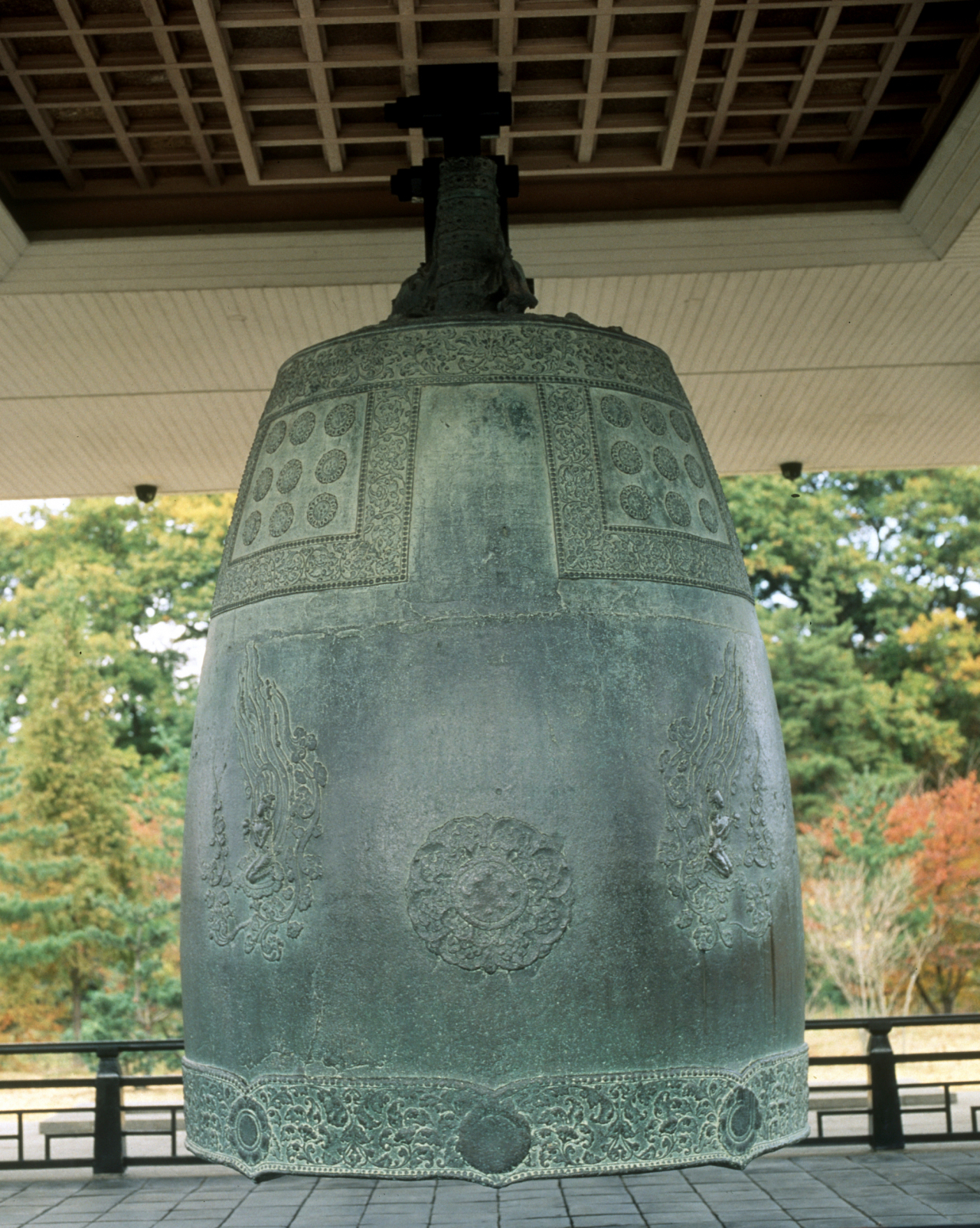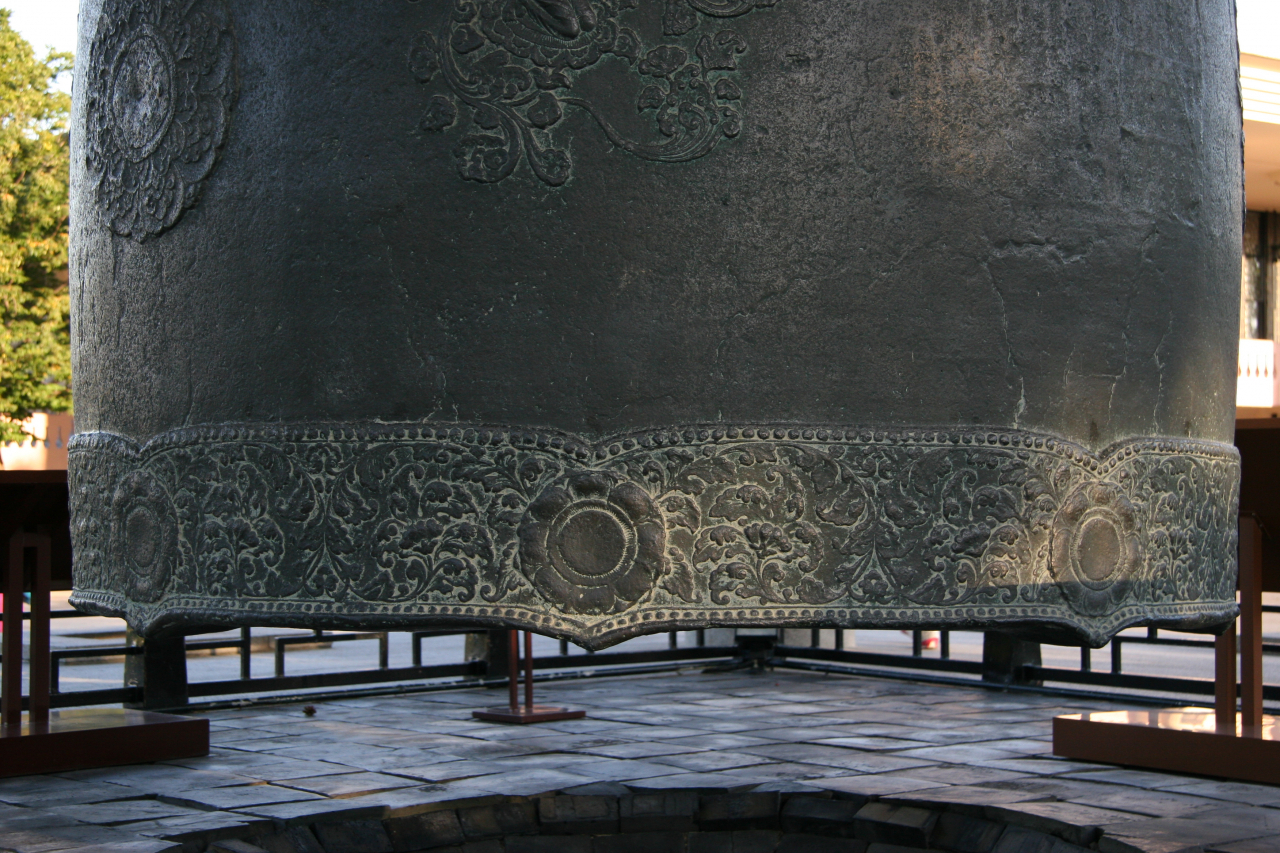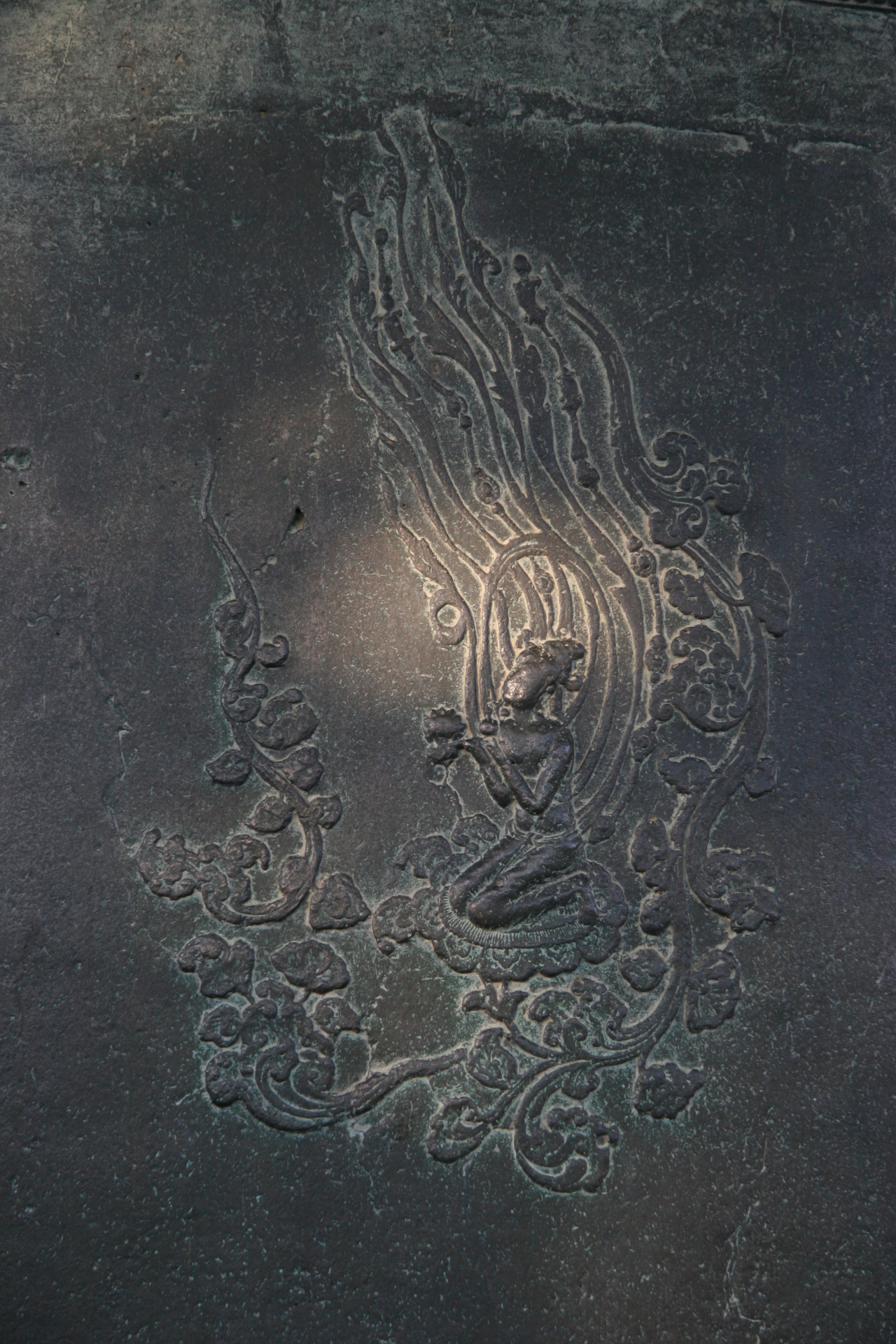 |
The Sacred Bell of King Seongdeok at Gyeongju National Museum in North Gyeongsang Province (Academy of Korean Studies) |
Historical artifacts often prompt us to ponder our scientific progress: Some objects made a thousand years ago just cannot be reproduced even with today's advanced technology.
The Sacred Bell of King Seongdeok at Gyeongju National Museum in Gyeongju, North Gyeongsang Province, is one such artifact -- how it was produced still remains largely unknown.
The Sacred Bell, designated National Treasure No. 29 in 1962, is the largest extant bell in Korea, although not the oldest.
The oldest known Korean bell is the Bronze Bell of Sangwonsa Temple, which dates back to 725, some 50 years before the Sacred Bell of King Seongdeok was cast.
The Sacred Bell is considered the most outstanding bell not only due to the exquisite craftsmanship showcased in the casting techniques, but also for its unique sound.
Many Koreans remember the bell from school visits to Gyeongju.
Even today, groups of young people listening attentively to their instructors are easily spotted at the Gyeongju museum complex.
The Sacred Bell was commissioned by King Gyeongdeok, the 35th ruler of Silla, to commemorate his father, King Seongdeok. King Gyeongdeok died before the task was completed, while the bell was completed in 771, during the reign of King Hyegong, King Seongdeok's grandson.
The 18.9-ton bell measures 3.75 meters in height, 7 meters in circumference and 2.27 meters in diameter at its widest point. Twenty-seven tons of bronze were used in the making of the bell, according to a 1997 study by the museum.
The bell is better known as the "Emille-jong," or Emille Bell, which derives from a myth that a baby was sacrificed to produce the bell, which took 34 years to make due to countless obstacles. "Emille" is the sound of the baby crying for its mother, according to the myth.
While the myth has captured the public's imagination, there is no written record of it through the end of the Joseon era -- the myth having surfaced only during the Japanese colonial period, according to Lee Jae-hyun, researcher at the Gyeongju National Museum.
 |
Lower part of the Sacred Bell of King Seongdeok at Gyeongju National Museum in North Gyeongsang Province (Academy of Korean Studies) |
Indeed, there are arguments that the story was maliciously concocted by the Japanese to denigrate the value of the bell, Lee explained.
The name, "Emille-jong," first appeared in the Maeil Sinbo, a newspaper published by the Japanese government-general of Korea, in August 1925. However, there are two conflicting opinions regarding which actual bell the article refers to -- the Bell of King Seongdeok or the Bosingak Bell.
In 1943, Ham Se-deok (1915-1950), a pro-Japanese writer, wrote and produced a play called "Eomillejong (1943)," which focused on urging Koreans to assimilate into Japanese culture.
But there is no concrete historical evidence supporting the theory that the Japanese created the myth behind the Sacred Bell.
Lee at Gyeongju Museum suggests that regardless of the origin of the purported myth, the fictional account did help generate general interest in the bell, prompting people to learn more about it.
The casting techniques of Silla some 1,250 years ago are still not fully understood today. Most engineers today agree that without blast furnaces and modern equipment, a bell of such size would have been extremely difficult to produce, according to the researcher.
A notable feature of the bell is that it is suspended from a horizontal metal rod measuring only 8.5 centimeters in diameter.
In 1975, when the bell was moved from its previous site, a former Japanese colonial era museum in Dongbu-dong, Gyeongju, to the Gyeongju museum, a plan was made to replace the old rod with a new steel one. But this proved impossible as any new rod that could hold such weight in suspension would be too thick to fit through the opening of the "yongru," or the dragon arch, at the top of the bell.
 |
A dragon arch at the top of the Sacred Bell of King Seongdeok at Gyeongju National Museum in North Gyeongsang Province (Academy of Korean Studies) |
According to modern engineering theories, the rod had to be at least 15 centimeters in diameter to withstand the bell's weight and hold the force when the bell is struck.
Although the exact composition still remains a mystery, research revealed that the original rod that still bears the bell's weight today, was created by hammering many thin layers of alloyed metals into a solid cylindrical mass.
Another interesting fact lies in the bell's sound.
The secret of the Sacred Bell's deep resonant notes, which echoed across the Silla Kingdom, lies in its unique structure.
A wooden bell pounder is used to strike the outside of Korean bells -- usually suspended slightly above the ground. The sound of the Sacred Bell can be heard for over 40 miles on a clear night, according to studies.
The bell has not been struck, except on special occasions, since 1992. However, museum visitors can hear the recorded sound of the bell at the top of every hour, as well as at the 20-minute and 40-minute marks. If you listen carefully, you can hear the sound reverberate for a long time after the single striking of the bell.
The lingering sound is attributed to the intentional asymmetry of the bell's design.
While most bells are made to be consistent in thickness throughout the structure, iron was added to the inside of the Sacred Bell of King Seongdeok. This asymmetrical composition results in two slightly different sound waves colliding with each other.
"First, you will be able to hear over 50 different sounds at once. Then slowly, all other sounds fade out, and only two remain." the researcher said. "One sound reaches 64 hertz while the other reaches 168 hertz. When these two sounds collide, they influence each other, resulting in the creation of a distinctive sound -- the bell's long-held secret."
The bell's main body shows depictions of heavenly beings, or Apsaras, in Buddhist culture. They hold incense burners in a reverential manner, as if presenting them to the Buddha and filling the air with a peaceful aroma. The depiction of the offering on the bell is also believed to be a means of praying for the peaceful rest of King Seongdeok's soul.
The intricate design of the Apsaras, with long and delicate lines of leaves and tendrils curling around them, enhances the bell's beauty and gives it an enchanting aura.
 |
A heavenly being, or Apsara, is depicted on the Sacred Bell of King Seongdeok. (Academy of Korean Studies) |
One side of the bell's body also features an inscription of roughly 1,037 ancient Chinese characters that recounts King Seongdeok's peaceful 40-year reign over the Silla Kingdom. The inscription writes that there were neither wars nor conflict, nor adversity faced by his people during his reign.
The inscription goes on to say that in recognition of his accomplishment, the government office commissioned the construction of the bell, and skilled artisans began crafting its design.
It writes that the final product was awe-inspiring, explaining the appearance of the bell as such: "The figure stood like a mountain, and the sound was like that of a dragon. ... Those who witnessed this (the bell) praised its uniqueness and those who heard the sound were blessed."
This article is the fifth in a series introducing well-known cultural artifacts from different periods in Korean history. -- Ed.






![[Today’s K-pop] Blackpink’s Jennie, Lisa invited to Coachella as solo acts](http://res.heraldm.com/phpwas/restmb_idxmake.php?idx=644&simg=/content/image/2024/11/21/20241121050099_0.jpg)
